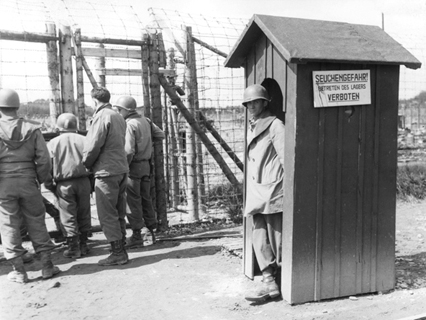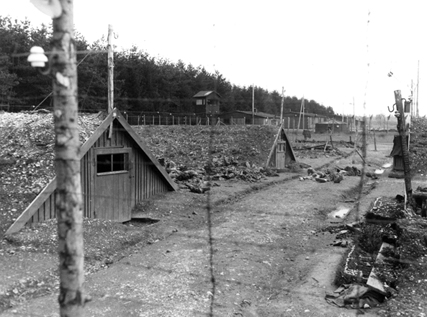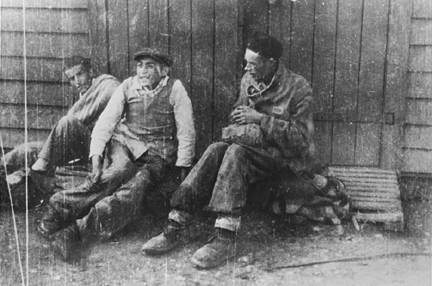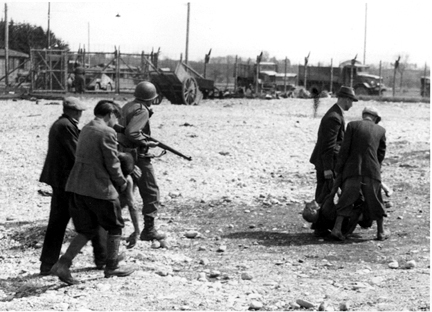Liberation of Kaufering IV Dachau sub-campThe photo below shows American soldiers standing at the gate into the Kaufering IV sub-camp of Dachau. The TV series "Band of Brothers" about the 101st Airborne Division recreated this scene in one of the episodes.  The Kaufering IV sub-camp of Dachau was liberated by the 12th Armored Division of the US Seventh Army on April 27, 1945 with help from soldiers in the 101st Airborne Division, who arrived on April 28, 1945. Kaufering IV was one of 11 camps, all named Kaufering and numbered I through XI, which were located near Landsberg am Lech, not far from the city of Munich. Kaufering IV had been designated as the sick camp where prisoners who could no longer work were sent. There was a typhus epidemic in Germany in 1945 and Kaufering prisoners with typhus were sent to the Kaufering IV camp to die. The Kaufering IV camp was near the town of Hurlach; the camp had previously been called Schwabmünchen.  The Dachau Concentration camp system included 123 sub-camps and Kommandos which were set up in 1943 when factories were built near the main camp to make use of the forced labor of the Dachau prisoners. These sub-camps were liberated by various divisions of the American army that unexpectedly came across them on their way to capture Munich. One battalion of the 63rd Infantry Division was ordered to search for the sub-camps in the Landsberg area. American soldiers in the 63rd Infantry Division liberated seven of the eleven Kaufering sub-camps on April 29th and 30th, 1945. These camps had already been evacuated and the prisoners had been marched to the main Dachau camp, but hundreds of weak and sick prisoners had been left behind. The 63rd Infantry Division was recognized as a liberating unit by the U.S. Army's Center of Military History and the United States Holocaust Memorial Museum in 2000. The 11 Kaufering sub-camps were set up specifically to build three huge underground factories for a project called Ringeltaube. In these subterranean factories, the German jet fighter plane Messerschmitt Me 262 was to be built. Allied bombing raids had made it necessary for the Nazis to build their factories underground; this had caused great suffering for the prisoners who were forced to do the work of constructing them.  In the last days of the war, in April 1945, all the Kaufering camps were evacuated except for the sick prisoners in the Kaufering IV camp, and around 15,000 prisoners were marched to the main Dachau camp. Some of the Kaufering prisoners arrived at the Dachau main camp on April 27, 1945, only two days before Dachau was liberated by American troops. On that same day, April 27, 1945, the Kaufering IV camp was liberated by the 12th Armored Division of the U.S. Army.  Approximately 14,500 prisoners in the 11 Kaufering camps died of hunger, cold weather, overwork and typhus. Conditions were far more severe at the Kaufering camps where the barracks buildings had been built partially underground in an attempt to hide the camp from Allied planes. When the 12th Armored Division first found the Kaufering IV camp on April 27th, there were hundreds of unburied bodies. The German civilians in Hurlach were forced, at gunpoint, to carry the bodies to mass graves for burial, as shown in the photo below.  Louis Vecchi of Benicia, CA was a member of the 506th Parachute Infantry Regiment of the 101st Airborne. In an interview with Rachel Raskin-Zrihen of the Benicia Times-Herald, Vecchi described the Kaufering IV camp. The following quote is from the Times-Herald September 25, 2007 edition: "It was the Landsberg slave labor camp (a Dachau death camp satellite camp)," Vecchi said. "When we got there, the people were practically dead from starvation. I know there are people who say the Holocaust didn't happen, but that's bull. I saw it." Gene Cook was a soldier in A company of the 506th Parachute Infantry Regiment of the 101st Airborne Division. After fighting in the Battle of the Bulge, Cook's unit was ordered to Hitler's vacation home in Berchtesgaden, according to an article by Alex McRae and Megan Almon in The Times-Herald, published on December 24, 2007. According to The Times-Herald article, on the way to Berchtesgaden, the soldiers of A Company "came across a strange complex circled with barbed wire. It was Landsberg, a satellite operation for the massive concentration camp at Dachau." The following quote is from the article written by McRae and Almon in The Times-Herald: Cook will never forget the sight. "I didn't even know what we were looking at," he says. "It took me a while to realize it was a pile of dead bodies." The prisoners came out of their quarters, emaciated, filthy and disoriented. "It was awful, "Cook says. "Some walked around like zombies. Some were so feeble they couldn't even stand." The prisoners all begged for food. Cook gave one man all he had - a small piece of cheese - and the man said in English "You are God in disguise." Late in the day, Cook saw a procession of men carrying what seemed to be a door with a purple cloth covering something. Cook learned the object beneath the cloth was soap made from the bodies of dead prisoners. He also learned the man he had given the cheese to was dead. Dr. Charles P. Larson, a US Army doctor, examined 258 bodies at the Kaufering IV camp and reported that 189 had probably died of typhus or starvation, while 86 had apparently been burned to death, 11 had been shot inside the camp and 17 more had been gunned down outside the camp. Dr. Larson also did autopsies on some of the bodies at the Dachau main camp and determined that none had died from poison gas. Apparently Dr. Larson did not test the soap that was found at the Kaufering IV camp, since no forensic report about human soap was ever entered as evidence by the American prosecutors at any of the post-war trials of the German war criminals. Nevertheless, Cook and other American veterans routinely tell these atrocity stories to gullible students who are studying the Holocaust in American schools. Bernie Marks, a survivor of the Kaufering IV camp, is a Polish Jew, born Ber Makowski on September 17, 1929 in Lodz, Poland. After the Germans invaded Poland on September 1, 1939, the Jews in Lodz volunteered to work for the Nazis in making uniforms for the German soldiers. The Lodz ghetto remained open until August 1944, when the last remaining Jews were sent to Auschwitz. Although the Kaufering IV camp near Hurlach was not evacuated because the prisoners there were all sick, including some who had typhus, Marks claims that he and his father jumped off a train taking them to the Dachau main camp. The following quote is from a news article in the Sacramento Bee on September 12, 2008, on the occasion of the upcoming Bar Mitzvah of Bernie Marks: "When we got off the transport (to Auschwitz), I was selected to go with my mother and younger brother, but my father spoke to an officer in his excellent German and asked if I could go with the men," said Marks. His father's quick thinking saved his life he never saw his mother and brother again. Marks and his father were transferred to Dachau and then Hurlauch (sic), one of Dachau's 11 slave labor camps. They worked in a gravel pit to build an underground bunker where the Nazis planned to manufacture Messerschmitt ME 262 jets, Marks said. "You were allowed 500 calories a day, usually a lousy slice of bread, and you didn't get that until you came back from work." [...] In April 1945, Marks was suffering typhoid fever when he and his father jumped from a train going back to Dachau. The Nazis opened fire with machine guns and both were wounded. "We never lost faith that freedom would come, and it did on April 27, 1945," said Marks, who was rescued with his father by the U.S. Army's 12th Armored Division. One of their liberators, Marvin Bertelson of Sunnyvale, has been invited to attend Marks' bar mitzvah.  The photograph above shows Commandant Johann Baptist Eichelsdorfer standing in the midst of the bodies found in the Kaufering IV camp. Note that the bodies in the foreground still have clothing, an indication that they died after the camp was liberated. Commandant Eichelsdorfer was captured a few days after the liberators arrived and brought back to the camp to be confronted with his crime; he was forced to stand in the middle of the corpses while the German civilians were encouraged to scream insults at him. Johann Baptist Eichelsdorfer was convicted by an American Military Tribunal at Dachau and sentenced to death; he was hanged at Landsberg prison, only a few miles from the Kaufering camp, on May 29, 1946. In the last months of the war, Otto Förschner was given the job of Commandant of the Kaufering I camp, which had also been designated as a sick camp for prisoners who could no longer work. Born in 1902, Förschner was an officer in the Waffen-SS who was transferred to concentration camp duty after he was wounded in battle. From August 1943 to February 1945, Förschner was the Commandant of KZ Mittlebau-Dora near the town of Nordhausen, where V-2 rockets were being manufactured in underground tunnels. Mittlebau-Dora was a sub-camp of Buchenwald. In the Buchenwald Report, a book that was written after the war by the prisoners, Förschner was praised by some of the inmates for improving conditions in the Mittlebau-Dora camp and for showing understanding of the prisoners' situation. Otto Förschner was one of the 28 accused men at the first American Military Tribunal at Dachau who were sentenced to death and executed; he was hanged at Landsberg prison on May 28, 1945. In December 1944, seven pregnant women in the Kaufering sub-camps were sent to the Kaufering IV camp where their babies were born between February and March 1945. Just before Dachau was liberated on April 29, 1945, the women and their babies were evacuated to the main camp. On the way, their train was hit by Allied bombs, and they arrived at Dachau after the camp had already been liberated. Mother with babies at DachauBack to Dachau LiberationBack to trial of Martin Gottfried WeissBack to Table of ContentsHomeThis page was last updated on March 3, 2009 |